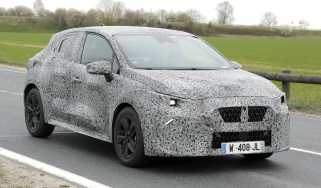Saab 9-5 Aero
Powerful new flagship is aiming high – and we see if it delivers
Swedish giant Saab nearly closed its doors for good only 12 months ago, but it survived the threat of extinction after being sold to Dutch supercar maker Spyker. The new 9-5 marked the first steps of recovery last year, and the new flagship Aero model is the next stage of the firm’s lengthy rehabilitation. So, is the powerful saloon a sign of good times ahead?
Well, if you want an executive car that stands out from the crowd, the flashy new 9-5 has a lot going for it. There’s plenty of Saab’s quirky DNA on display here, including the wraparound-style windscreen and distinctive grille.
Yet modern touches such as blue-tinted ice-block lights and LED daytime running lamps ensure the car doesn’t seem like a retro pastiche.
New Aero trim enhances the look of the standard model with redesigned bumpers, lowered suspension, 19-inch turbine alloy wheels and twin exhaust pipes. The result is a car with huge physical presence on the road, although much of the credit for this has to go to its dimensions, which put it closer to the luxury Mercedes S-Class in terms of size. It’s 140mm longer than the E-Class, at 5,008mm, and this pays dividends inside, where rear passengers are treated to 125mm more legroom. Our car even had TV screens and separate audio controls in the back (a £2,760 option), ensuring a limo-style experience. The only downside is that the sloping roofline restricts rear headroom for tall occupants.
Used - available now

2020 Land Rover
Range Rover Velar
52,600 milesAutomaticPetrol5.0L
Cash £41,995
2023 Porsche
Cayenne Coupe
37,000 milesAutomaticPetrol2.9L
Cash £55,995
2020 Ford
Kuga
5,063 milesAutomaticPetrol2.5L
Cash £23,100
2023 Ford
Kuga
25,720 milesAutomaticPetrol2.5L
Cash £21,700There’s plenty of space up front, and the cabin isn’t short of trademark Saab touches. The sweeping dash design, starter button located between the seats, unique air vents and green instrument illumination all hark back to previous models.
However, this hasn’t come at the expense of more modern details. There’s a large colour touchscreen for the optional sat-nav, climate control, a powerful stereo and a multifunction digital display in the middle of the speedometer.
Buyers can even specify an aircraft-inspired head-up display system (£615) and ventilated leather seats (£1,075) from the options list. The standard sports chairs are electrically adjustable, and although they sit higher than those in the Mercedes, they offer greater adjustment and support. Our car was equipped with the optional DriveSense system (£1,175), which can be used to fine-tune steering, suspension, gearbox, engine and four-wheel-drive settings. This doesn’t mask the 9-5’s dynamic shortcomings, though.
The steering weight improves in Sport mode, but it is never wholly consistent and offers minimal feedback. Also, the six-speed box is too keen to kick down. Its changes are slow and ponderous as well – even when you use the wheel-mounted paddles to shift ratios manually.
To help contain the 296bhp developed by its turbocharged 2.8-litre V6, the Aero is fitted with Saab’s XWD all-wheel-drive system. This can split power between the front and rear axles, and direct as much as 80 per cent of drive to the back. It’s effective, too, and traction off the line is impressive. Despite the wet conditions on test, the car blasted from 0-60mph in 6.4 seconds with barely a hint of wheelspin. This performance was no doubt aided by the electronically controlled limited-slip differential. It comes with the DriveSense system and splits torque between the rear wheels (directing it to the tyre with more grip), thus improving cornering ability and boosting confidence.
The big Swede was equally impressive in our braking tests, with impressive stopping power. However, its in-gear responses were blunted by the long gearing of its six-speed auto – at 70mph, the engine turns at a lowly 1,800rpm. Switch the DriveSense controller out of Sport mode, and the suspension does a good job of controlling body movements and absorbing bumps. The Saab does fidget on lightly pitted surfaces which don’t faze the Mercedes, though. This is probably a legacy of the 9-5’s huge 19-inch alloys.
If the comfort difference between the two cars is small, the Saab is soundly beaten by the Mercedes in the quest to be clean and efficient. The Aero’s quoted combined economy of 26.6mpg is simply no longer competitive in this sector – and neither are CO2 emissions of 244g/km.
Also, although the Saab costs less and comes with more standard kit, it isn’t such an appealing long-term ownership proposition thanks to our experts’ lower residual predictions.
Ultimately, while the new 9-5 Aero is sure to delight marque enthusiasts, buyers with no loyalty to the brand are unlikely to be swayed by the benefits of its four-wheel-drive hardware and rarity value.
Details
Chart position: 2
WHY: New 9-5 Aero has an enviable specification list, including a powerful V6 turbo engine and advanced four-wheel drive. It also looks the part, and the huge cabin is generously equipped.







